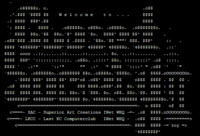New media art
From Wikipedia, the free encyclopedia
New media art is an art genre that encompasses artworks created with new media technologies, including digital art, computer graphics, computer animation, virtual art, Internet art, interactive art technologies, computer robotics, and art as biotechnology. The term differentiates itself by its resulting cultural objects, which can be seen in opposition to those deriving from old media arts (i.e. traditional painting, sculpture, etc.) This concern with medium is a key feature of much contemporary art and indeed many art schools now offer a major in "New Genres" or "New Media".
New Media concerns are often derived from the telecommunications, mass media and digital modes of delivery the artworks involve, with practices ranging from conceptual to virtual art, performance to installation.
Contents |
[edit] History
The origins of new media art can be traced to the moving photographic inventions of the late 19th Century such as the zoetrope (1834), the praxinoscope (1877) and Eadweard Muybridge's zoopraxiscope (1879).
During the 1960s the development of then new technologies of video produced the new media art experiments of Nam June Paik and Wolf Vostell, and multimedia performances of Fluxus. At the end of the of the 1980s the development of computer graphics, combined with real time technologies then in the 1990s with the spreading of the Web and the Internet favorished the emerging of new and various forms of interactivity Lynn Hershman Leeson, David Rokeby, Perry Hoberman, Internet Vuk Ćosić, Jodi, virtual and immmersive art Jeffrey Shaw, Maurice Benayoun and large scale urban installation Rafael Lozano-Hemmer.
Simultaneously advances in biotechnology have also allowed artists like Eduardo Kac to begin exploring DNA and genetics as a new art medium.
Contemporary New Media Art influences on new media art have been the theories developed around hypertext, databases, and networks. Important thinkers in this regard have been Vannevar Bush and Theodor Nelson with important contributions from the literary works of Jorge Luis Borges, Italo Calvino, Julio Cortázar and Douglas Cooper. These elements have been especially revolutionary for the field of narrative and anti-narrative studies, leading explorations into areas such as non-linear and interactive narratives.
[edit] Themes

In their book New Media Art, Mark Tribe and Reena Jena name several themes that contemporary new media art addresses, including computer art, collaboration, identity, appropriation and open sourcing, telepresence and surveillance, corporate parody, as well as intervention and hacktivism. (Tribe, Mark; Jena, Reena (2007-02-22). "New Media Art - Introduction". New Media Art. Taschen/Brown. https://wiki.brown.edu/confluence/display/MarkTribe/New+Media+Art+-+Introduction. Retrieved on 2007-11-29.)
The interconnectivity and interactivity of the internet, as well as the fight between corporate interests, governmental interests, and public interests that gave birth to the web and continues today, fascinate and inspire a lot of current New Media Art.
[edit] Presentation & Preservation
As the technologies used to deliver works of new media art such as film, tapes, web browsers, software and operating systems become obsolete, New Media art faces serious issues around the challenge to preserve artwork beyond the time of its contemporary production. Currently, research projects into New media art preservation are underway to improve the preservation and documentation of the fragile media arts heritage (see DOCAM - Documentation and Conservation of the Media Arts Heritage).
Methods of preservation exist, including the translation of a work from an obsolete medium into a related new medium,[1] the digital archiving of media (see Internet Archive), and the use of emulators to preserve work dependent on obsolete software or operating system environments.[2][3]
[edit] Types
The term New Media Art is generally applied to disciplines such as:
- Artistic computer game modification
- Ascii Art
- Bio Art
- Computer art
- Digital art
- Digital poetry
- Tradigital art
- Electronic art
- Evolutionary art
- Generative art
- Hacktivism
- Information art
- Interactive art
- Internet art
- Net art
- Performance art
- Radio art
- Robotic art
- Software art
- Sound art
- Systems art
- Video art
- Virtual art
[edit] New media artists
- Miguel Álvarez-Fernández
- Carlos Amorales
- Cory Arcangel
- Roy Ascott
- Maurice Benayoun
- Brody Condon
- Luc Courchesne
- Ronald Davis
- Heiko Daxl
- Agricola de Cologne
- DJ Lotu5 (aka Micha Cárdenas)
- David Em
- Ken Feingold
- Ingeborg Fülepp
- Peter Benjamin Graham
- Phil Hansen
- Lynn Hershman
- Perry Hoberman
- G.H. Hovagimyan
- Junichi Kakizaki
- KMA
- Knowbotic Research
- Roy LaGrone
- Golan Levin
- Rafael Lozano-Hemmer
- Christian Moeller
- Manfred Mohr
- Francesco Monico
- Michael Naimark
- Joseph Nechvatal
- Graham Nicholls
- Randall Packer
- Zaven Paré
- Melinda Rackham
- Ken Rinaldo
- Don Ritter
- David Rokeby
- Jason Salavon
- Scott Snibbe
- Camille Utterback
[edit] References
[edit] Further reading
- Roy Ascott (2003). Telematic Embrace: Visionary Theories of Art, Technology, and Consciousness (Ed.) Edward A. Shanken. Berkeley: University of California Press. ISBN 978-0520218031
- Barreto, Ricardo and Perissinotto, Paula “the_culture_of_immanence”, in Internet Art. Ricardo Barreto e Paula Perissinotto (orgs.). São Paulo, IMESP, 2002. ISBN 85-7060-038-0.
- Christine Buci-Glucksmann, "L’art à l’époque virtuel", in Frontières esthétiques de l’art, Arts 8, Paris: L’Harmattan, 2004
- Frank Popper (2007) From Technological to Virtual Art, MIT Press/Leonardo Books
- Lev Manovich (2001). The Language of New Media Cambridge, Masschusetts: The MIT Press/Leonardo Books. ISBN 0-262-63255-1
- Dick Higgins, ‘Intermedia’ (1966), reprinted in Donna De Salvo (ed.), Open Systems Rethinking Art c. 1970, London: Tate Publishing, 2005
- Nicolas Bourriaud, (1997) Relational Aesthetics, Dijon: Les Presses du Réel, 2002, orig. 1997
- Charlie Gere, (2002) Digital Culture, Reaktion ISBN 978-1861891433
- Lev Manovich, Ten Key Texts on Digital Art: 1970-2000 Leonardo - Volume 35, Number 5, October 2002, pp. 567-569
- Charlie Gere, (2006) White Heat, Cold Logic: Early British Computer Art, co-edited with Paul Brown, Catherine Mason and Nicholas Lambert, MIT Press/Leonardo Books
- Graham, Philip Mitchell, New Epoch Art, InterACTA: Journal of the Art Teachers Association of Victoria, Published by ACTA, Parkville, Victoria, No 4, 1990, ISSN 0159-9135, Cited In APAIS. This database is available on the, Informit Online Internet Service or on CD-ROM, or on Australian Public Affairs - Full Text
- Mark Hansen, (2004) New Philosophy for New Media (Cambridge, MA: MIT Press
- Rainer Usselmann, (2003)"The Dilemma of Media Art: Cybernetic Serendipity at the ICA London",Cambridge, Masschusetts: The MIT Press/Leonardo Journal - Volume 36, Number 5, pp. 389-396
- Rainer Usselmann, (2002)"About Interface: Actualisation and Totality",University of Southampton
- Paul, Christiane (2003). Digital Art (World of Art series). London: Thames & Hudson. ISBN 0-500-20367-9.
- Fleischmann, Monika and Reinhard, Ulrike (eds.). Digital Transformations - Media Art as at the Interface between Art, Science, Economy and Society online at netzspannung.org, 2004, ISBN 3-934013-38-4
- Fleischmann, Monika & Strauss, Wolfgang (eds.) (2001). Proceedings of »CAST01//Living in Mixed Realities« Intl. Conf. On Communication of Art, Science and Technology, Fraunhofer IMK 2001, 401. ISSN 1618–1379 (Print), ISSN 1618–1387 (Internet).
- Gatti, Gianna Maria. (2009) The Technological Herbarium. Avinus Verlag, Berlin, 2009 (edited, translated from the Italian, and with a preface by Alan N. Shapiro).
- Oliver Grau (2003). Virtual Art: From Illusion to Immersion (Leonardo Book Series). Cambridge, Massachusetts: The MIT Press/Leonardo Books. ISBN 0-262-07241-6.
- Randall Packer & Ken Jordan (2001) Multimedia: From Wagner to Virtual Reality, W.W. Norton. ISBN 039332375
- Frank Popper (1997) Art of the Electronic Age, Thames & Hudson
- Robert C. Morgan, Commentaries on the New Media Arts Pasadena, CA: Umbrella Associates,1992
- Oliver Grau (2007). (Ed.) MediaArtHistories. Cambridge, Massachusetts: The MIT Press/Leonardo Books. ISBN 0262072793.
- Edward A. Shanken Selected Writings on Art and Technology http://artexetra.com
- Edward A. Shanken Art and Electronic Media. London: Phaidon, 2009. ISBN 9780714847825
- Christine Buci-Glucksmann, La folie du voir: Une esthétique du virtuel, Galilée, 2002
- Mark Tribe and Reena Jana. New Media Art. https://wiki.brown.edu/confluence/x/Wkg
- Whitelaw, Mitchell (2004). Metacreation: Art and Artificial Life Cambridge, Massachusetts: The MIT Press. ISBN 0-262-73176-2.
- Wands, Bruce (2006). Art of the Digital Age, London: Thames & Hudson. ISBN 0-500-23817-0.
- Youngblood, Gene (1970). Expanded Cinema. New York. E.P. Dutton & Company.
[edit] See also
- Experiments in Art and Technology
- Net.art
- Electronic Language International Festival
- Digital art
- Digital puppetry
- DOCAM: Documentation and Conservation of the Media Arts Heritage
- Electronic art
- Intermedia
- New Epoch Notation Painting
- New Media art festivals
- Interactive film
- New media art journals
- New media art preservation
[edit] External links
- ASPECT- The Chronicle of New Media Art
- Glare Media Art Resources - Pioneering Media Art International Distribution
- NewMediaArtProjectNetwork: Cologne - experimental platform for art and New Media
- Share - international organization supporting 'open multimedia jams' throughout the world
- CyLand MediaLab - new artistic laboratory created by St. Petersburg branch of National Center for Contemporary Arts, Russia
- Media Arts at Eastern Oregon University - innovative new media art program offering degrees in three concentrations; digital media, journalism, and film studies.
- RHIZOME- An online resource and blog about contemporary new media artists (connected to the New Museum)
- SWITCH- An online journal of contemporary media culture
- NAMAC- The National Alliance for Media Arts and Culture
- LEONARDO- Leonardo/The International Society for the Arts, Sciences and Technology
- ZKM- Center for Art and Media Karlsruhe



